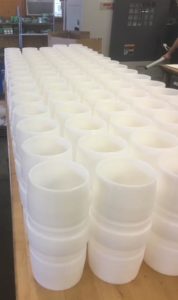
Choosing the right material for your product can mean the difference between a good product and a great one. When it comes to high-performance thermoplastic resins, the debate is often UHMW vs. acetal. Both offer strength and excellent performance in wear applications, but their differences come into play when considering your application.
UHMW is the highest-quality polyethylene available. Its high molecular weight makes the material strong enough to withstand abrasion and impact better than lower-level polymers, but also means it will not melt or flow as a molten liquid. Therefore, it cannot be transformed and molded by conventional plastic processing techniques (such as injection molding), but is suitable for machining and fabrication.
This low-cost plastic has all the characteristics of high-density polyethylene (HDPE) with the added benefits of being resistant to concentrated acids and alkalis as well as many organic solvents. It is highly resistant to corrosive chemicals (except for oxidising acids); has extremely low moisture absorption; is low friction and self-lubricating; is highly resistant to abrasion (up to 15 times more abrasion resistant than carbon steel).
UHMW’s simple molecular structure gives it surface and chemical properties rare in high-performance polymers. For example, it is does not absorb water readily or interact strongly with skin, making it feel slippery. It is also very resistant to moisture, most chemicals, UV radiation, and micro-organisms. While it has a significantly lower coefficient of friction than acetal, it doesn’t boast the same creep resistance.
UHMW is used in:
Acetal boasts high tensile and flexural strength, stiffness, and fatigue endurance. It also has high resistance to solvents and chemicals, low friction, excellent dimensional stability, and great abrasion resistance. Acetal’s excellent creep resistance makes it perfect for precise high-performance parts. Good electrical properties give acetal long-term stability in electrical applications, and with low moisture absorption, molded acetal parts can perform reliably in environments that experience humidity changes.
Acetal’s drawbacks include flammability, poor resistance to acids, and UV degradation. Its high resistance to chemicals also makes it difficult to bond. However, it is easy to machine as it can be sawed, turned, milled, drilled, shaped, reamed, blanked and punched, threaded and tapped, filed, sanded, and polished. Acetal parts are easy to join and offer a wide variety of assembly options. It is also extremely adaptable to secondary operations, particularly hot stamping.
If you find yourself debating UHMW vs. acetal for your next project, call the experts at Reading Plastic: 610-926-3245. We can help you choose the right material to meet all your machining and fabrication needs.